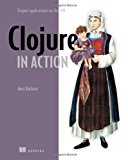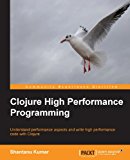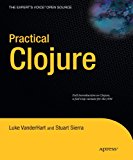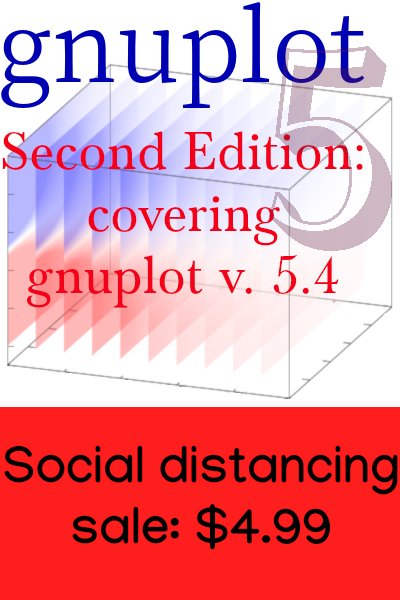3/9/2021 12:37 Joker: “Joker is a small interpreted dialect of Clojure written in Go. It is also a Clojure(Script) linter.”
7/6/2017 13:55 Reducers, transducers and core.async in Clojure: “This is a whirlwind tour of some of the cool new features that appeared in Clojure in the past few years. I find it fascinating how one good idea (reducers) morphed into another (transducers), and ended up mating with yet another, apparently unrelated concept (concurrent pipelines) to produce some really powerful coding abstractions.”
31/3/2017 13:01 Manipulating the DOM with Clojure using Klipse: “The Klipse plugin is a client-side code evaluator.
This means that inside a web page, you are not limited to manipulate data, but you can also manipulate the DOM.
In this article we will show 4 approaches for manipulating the DOM with Clojure using Klipse”.
2/3/2017 08:18 Clojure Error Message Catalog: “We are experimenting with starting a community driven catalog of common errors. […] The idea is that people can submit an issue with a particular error, or make a pull request with the error, description and hopefuly one or two solutions to resolve it.”
31/10/2016 18:47 Boot: A system for using Clojure as a scripting laguage.
23/5/2016 10:33 Introducing clojure.spec: “a new core library and support for data and function specifications in Clojure.” And: “Clojure is a dynamic language, and thus far we have relied on documentation or external libraries to explain the use and behavior of functions and libraries. But documentation is difficult to produce […] Specs are expressive and precise. Including spec in Clojure creates a lingua franca with which we can state how our programs work and how to use them.”
16/5/2016 10:51 A few tips for writing macros in Clojure: “they can be tricky to get right, especially in a legible way. These guidelines will serve beginning and intermediate macro programmers well. Advanced programmers will know when to ignore the guides.”
19/4/2016 13:45 Clojure, The Good Parts: Some opinionated but thoughtful advice on “what a ‘good’ production Clojure app looks like in 2016.” See also the
discussion on Hacker News.
13/9/2015 13:50 Sparklines: A clojure program for making the little graphs.
18/8/2015 8:29 Parens of the Dead: “A screencast series of zombie-themed games written with Clojure and ClojureScript.”
7/8/2015 16:11 Neanderthal: Fast Native Matrix and Linear Algebra in Clojure: “Neanderthal implements BLAS algorithms and abstracts most of that complexity for vector and matrix computations away, behind a frendly Clojure API.[…] Optimized GPU engine 500x faster for large matrices than the fastest Java libraries. Handcrafted JNI bindings for machine-optimized ATLAS BLAS, 10x faster than optimized Java libraries on the CPU.”
31/7/2015 14:11 ClojureScript Next: ClojureScript can now compile itself. This means that you can make a web page that allows the user to type in ClojureScript and evaluate it. That, of course, is just the tip of the iceberg of awesomeness.
Reducers, transducers and core.async in Clojure: “This is a whirlwind tour of some of the cool new features that appeared in Clojure in the past few years. I find it fascinating how one good idea (reducers) morphed into another (transducers), and ended up mating with yet another, apparently unrelated concept (concurrent pipelines) to produce some really powerful coding abstractions.”
Exploring the Clojurescript REPL: “A beginner-level exploration of a ClojureScript REPL session complete with mistakes of the type made by me so that you might avoid these common pitfalls when starting your own ClojureScript adventures.”
re-com Demo: “Re-com is a library of ClojureScript UI components, built on top of Reagent.”
A few tips for writing macros in Clojure: “they can be tricky to get right, especially in a legible way. These guidelines will serve beginning and intermediate macro programmers well. Advanced programmers will know when to ignore the guides.”
Clojure Cookbookis Coming: “We want this O’Reilly cookbook to be a comprehensive resource containing the collective wisdom of Clojurists from every domain. […] Share some code. Explain it. Be a part of Clojure history. […] O’Reilly will sell
Clojure Cookbook in physical form, and will also make it available as an ebook (in multiple formats), freely redistributable under a Creative Commons license.”
An Om Tutorial: A tutorial on the ClojureScript Om framework, optimized for Light Table.
Clojure Grimoire: “Community documentation of Clojure” – A convenient table of Clojure things.
Full Stack Boot Example: “This is a sample project that demonstrates how to create a full stack (Clojure + ClojureScript) project using the Boot build tool. With boot run, you can instantly see your project at http://localhost:3000/ and any edits to the ClojureScript will be automatically pushed to the browser. With boot build, you can make a standalone JAR file that includes your entire client and server code.”
20 Cool Clojure Functions: “One of my favorite things about Clojure is that there are just so many really neat, useful functions and macros built into the language, and I’m constantly learning about new ones that I didn’t know existed. I thought I would share with you some of my favorites.”
Clojure, The Good Parts: Some opinionated but thoughtful advice on “what a ‘good’ production Clojure app looks like in 2016.” See also the
discussion on Hacker News.
Processing documents with transducers: “In this article we will develop a set of transducers which can be composed to extract data from an XML document (although the principles here can be applied to any tree-structured format, including JSON).”
Modern ClojureScript: “Modern ClojureScript (modern-cljs) is a series of tutorials that guide you in creating and running ClojureScript (CLJS) projects.”
ClojureScript Tutorials: Mimmo Cosenza’s series of tutorials “will guide you in creating, setting up and running simple CLJS projects. The series follows a progressive enhancement of projects themselves.”
Macros are Hard!: Talk with slides by David McNeil shows how you need to think deeply about what’s going on behind the scenes in order to understand what is happening with macros in
Clojure[@clojure].
Closp Documentation: “Closp is a leiningen template that generates everything you need to get started with clojure web development.”
Pedestal: Build web apps in Clojure: This is the current incarnation of the ClojurescriptOne project. “Built with components that play nice together & can be re-assembled at will.”
Shoreleave: “Shoreleave is a collection of integrated libraries that focuses on:
-
Security
-
Idiomatic interfaces
-
Common client-side strategies
-
HTML5 capabilities
-
ClojureScript’s advantages
It builds upon efforts found in other ClojureScript projects, such as Fetch and ClojureScript:One.”
In version 0.2.2, and I’ve heard good things about it.
ClojureHomePage: “ClojureHomePage is a Compojure based web framework that allows you to write the backend and frontend with Clojure.”
Hiccup: “Fast library for rendering HTML in Clojure”.
Liberator: “Liberator is a Clojure library that helps you expose your data as resources while automatically complying with all the relevant requirements of the HTTP specification (RFC-2616). Your resources will automatically gain useful HTTP features, such as caching and content negotiation. Liberator was inspired by Erlang’s Webmachine. […] liberator will enable you to create application according to a REST architecture.”
Hoplon: “Write everything in Clojure and ClojureScript, clientside and serverside. Even the page markup is ClojureScript that is evaluated to produce the DOM.” And: “Use a spreadsheet-like dataflow programming environment to manage client state.”
webfui: Client-side web framework for ClojureScript with an emphasis on simplifying DOM manipulations. See the
movie.
Taking Off the Blindfold: “Om now supports a very useful notion called instrumenting which allows us to peek under the blindfold without changing any of the original code.”
Luminus: “a micro-framework based on a set of lightweight libraries. It aims to provide a robust, scalable, and easy to use platform. With Luminus you can focus on developing your app the way you want without any distractions.”
The request and response guts that most of the frameworks seem to be based on is called Ring.
Clojure implemented in javascript aimed at Google Closure. Has most of Clojure except for concurrency and the Java interface (for obvious reasons). Write Gmail in lisp.
Servant: A Clojurescript Library for Using Web Workers that claims to allow you to write “clean, multithreaded, ClojureScript.”
ClojureScript Next: ClojureScript can now compile itself. This means that you can make a web page that allows the user to type in ClojureScript and evaluate it. That, of course, is just the tip of the iceberg of awesomeness.
Exploring the Clojurescript REPL: “A beginner-level exploration of a ClojureScript REPL session complete with mistakes of the type made by me so that you might avoid these common pitfalls when starting your own ClojureScript adventures.”
Himera: ClojureScript compiler as web service.
Re-frame: A framework for writing single page applications with clojurescript and Reagent.
re-com Demo: “Re-com is a library of ClojureScript UI components, built on top of Reagent.”
lein-figwheel: “Figwheel builds your ClojureScript code and hot loads it into the browser as you are coding”.
ClojureScript Quick Start: David Nolen explains how to set up your workflow. This page has been around for a long time and the author keeps it up to date.
An Om Tutorial: A tutorial on the ClojureScript Om framework, optimized for Light Table.
ClojureScript 101: Clear example from David Nolen showing how to use core.async to process events.
Functional programming on frontend with React & ClojureScript: “In this blog post I will show advantages of React way of building scalable and well performing web applications with taste of functional programming. In this tutorial we will introduce basics of ClojureScript as well and show how React plays nicely with ClojureScript through one of its wrappers called Reagent. Working app is included as well.”
ClojureScript: Lisp’s Revenge: David Nolen, a javascript programmer for the New York Times, gives a clear and inspiring talk, rich with demos, illustrating the joy of using ClojureScript. The movie is presented superbly as well: you can actually read the code.
Full Stack Boot Example: “This is a sample project that demonstrates how to create a full stack (Clojure + ClojureScript) project using the Boot build tool. With boot run, you can instantly see your project at http://localhost:3000/ and any edits to the ClojureScript will be automatically pushed to the browser. With boot build, you can make a standalone JAR file that includes your entire client and server code.”
omchaya: A ClojureScript + Om client for Kandan, which is some kind of chat program. “An example app that’s actually useful.”
Rouge in Pedestal: Falling block game using only the data UI. Should be a good example of how to program with Pedestal.
Devcards: When using clojurescript with React or Om, Devcards allows you to see different states of your UI in the browser at the same time.
Interactive Programming in ClojureScript: A Leiningen plugin (Figwheel) that gets the browser reloading on save, to allow simple interactive programming in ClojureScript. Includes a movie of the author live-coding a flappy bird game.
Parens of the Dead: “A screencast series of zombie-themed games written with Clojure and ClojureScript.”
ClojureScript Tutorials: Mimmo Cosenza’s series of tutorials “will guide you in creating, setting up and running simple CLJS projects. The series follows a progressive enhancement of projects themselves.”
Modern ClojureScript: “Modern ClojureScript (modern-cljs) is a series of tutorials that guide you in creating and running ClojureScript (CLJS) projects.”
cljs-template: One way to learn and get started with clojurescript.
The Future of JavaScript MVC Frameworks: David Nolen introduces OM, a library for using ClojureScript with React.js. A fascinating story showing how a cleaner high-level view can lead to significant gains in efficiency as well as more enjoyable coding.
shadow-cljs: “ClojureScript compilation made easy!” I hear a lot of good things about this.
“A short demonstration of using the ClojureScript browser-connected REPL to work with the twitterbuzz sample application.” This little movie by Brenton Ashworth is quite cool. He locally connects the ClojureScript REPL to a browser and can type ClojureScript whose side effects appear as browser behaviors.
Grenchman: A persistent JVM/nREPL that maintains state and allows you to run clojure code without waiting for JVM startup.
Onyx: This is “a masterless, cloud scale, fault tolerant, distributed computation system.”
Chord: “A library designed to bridge the gap between the triad of CLJ/CLJS, web-sockets and core.async […] Chord only has one function,
chord.client/ws-ch, which takes a web-socket URL and returns a channel. When the connection opens successfully, this channel then returns a two-way channel that you can use to communicate with the web-socket server”.
Clojure core.async Channels: A major new library for
Clojure[@clojure], described by Rich Hickey with his usual conceptual clarity: “Events complect communication and flow of control.” .
Neanderthal: Fast Native Matrix and Linear Algebra in Clojure: “Neanderthal implements BLAS algorithms and abstracts most of that complexity for vector and matrix computations away, behind a frendly Clojure API.[…] Optimized GPU engine 500x faster for large matrices than the fastest Java libraries. Handcrafted JNI bindings for machine-optimized ATLAS BLAS, 10x faster than optimized Java libraries on the CPU.”
Clatrix: A matrix library. “Being implemented as a data type around the native BLAS hooks of jblas gives it speed. Being implemented as a Clojure sequence makes it clever.”
Imagez: Here is an image processing library for Clojure that seems quite simple to use.
Channels: “A channel represents a stream of messages. It consists of two parts, a node, which propagates messages downstream, and a queue, which stores messages when there are no downstream nodes.”
eastwood - a Clojure lint tool: “Eastwood is a clojure lint tool which uses the analyze library to inspect namespaces and report possible problems. Currently it should works with projects running Clojure 1.3.0 and newer.”
π in Clojure: “After reading Carl Sagan’s
Contact I’m crushing on π, so I looked it up on Wikipedia, where, of course, several algorithms for computing it are described in detail. One of them, the Brent-Salamin algorithm, has the really neat property of doubling the number of digits it gets right on each iteration.”
Clojure Style Guide: “best practices so that real-world Clojure programmers can write code that can be maintained by other real-world Clojure programmers.”
Introducing clojure.spec: “a new core library and support for data and function specifications in Clojure.” And: “Clojure is a dynamic language, and thus far we have relied on documentation or external libraries to explain the use and behavior of functions and libraries. But documentation is difficult to produce […] Specs are expressive and precise. Including spec in Clojure creates a lingua franca with which we can state how our programs work and how to use them.”
core.matrix performance: core.matrix is a library for Clojure that allows fast arraywise arithmetic on multidimensional arrays. The performance in these benchmarks is very impressive.
Planet Clojure: A “meta blog that collects posts from the blogs of various Clojure hackers and contributors.”
Transducers are fundamental: Ignacio Thayer: “Transducers are being introduced in the next version of clojure. There are a few posts about them already, but I found the notion of transducers more elegant and natural than I have seen described. They simplify a lot of disparate clojure concepts and make it easier to write more performant code without any loss in generality. They are quite beautiful, actually, and I believe the concept is elemental, like function composition.”
Clojure 1.4 Announced: A new version of this extremely practical Lisp has been released. An interesting new feature is Reader Literals, which function as a kind of namespaced reader macro.
rhymes.clj: The inimitable Paul Ford’s adventure in Clojure land, in the form of (heavily) commented code on GitHub.
Joker: “Joker is a small interpreted dialect of Clojure written in Go. It is also a Clojure(Script) linter.”
Clojure Error Message Catalog: “We are experimenting with starting a community driven catalog of common errors. […] The idea is that people can submit an issue with a particular error, or make a pull request with the error, description and hopefuly one or two solutions to resolve it.”
Using Clojure At MixRadio: “we’ve been using Clojure to power our backend at MixRadio. We’ve moved from a largely Java platform to one where almost all new development is done in Clojure.”
Talk on a New Kind of REPL: This video of Kovas Boguta’s talk on
Session, a new idea for richly interacting with Clojure, devotes its first half to demonstrating how cool
Mathematica is.
Code Fatigue: A an example of how using advanced language features can make a program (
clojure[@clojure] in this case) easier to understand, by reducing the number of things you need to keep in your head to form a mental model of the code.
Not Code as Data: Mark Bastian discovers that Java tutorialists have begun falsely claiming that Java now features “code as data.” He explains what that really means, using Clojure examples.
Sparklines: A clojure program for making the little graphs.
Clojure at a Newspaper: “fundamentally we hadn’t written much code. I raised this sheepishly with the CTO and his response was: ‘that’s how I know it’s the right solution.’ Clojure is the winner here.”
ClojureScript Macro-Functions: In ClojureScript, unlike Clojure, a macro and a function can share a name. This article explores the implications.
Design, Composition and Performance: All of Rich Hickey’s presentations are worth watching. This one is astonishing in the depth of its insights and its use of brilliant, multilayered analogies.
Manipulating the DOM with Clojure using Klipse: “The Klipse plugin is a client-side code evaluator.
This means that inside a web page, you are not limited to manipulate data, but you can also manipulate the DOM.
In this article we will show 4 approaches for manipulating the DOM with Clojure using Klipse”.
Simple Made Easy: Rich Hickey, the author of
Clojure[@clojure], explains the difference between
simple and
easy in this often humorous talk. This is from October 2011, but I just found out about it, and it’s well worth sitting through.
Deploying a Clojure web app to a VPS: Adam Bard: “So you wrote an app. Great! Next step is to put it somewhere where people can use it. This tutorial will walk you through the process of deploying your app.”
Clojure in the Open: “a weekly newsletter bringing interesting and simple tasks from small to medium open source projects that anyone can contribute to.” Seems like a great idea. A bit hard to read with the current low-contrast style, but they’re working on it.
IClojure: “An Interactive Clojure repl, inspired by IPython.”
Clojure Web Security: Aaron Bedra’s talk about the scary state of security in the current crop of Clojure web applications, and what can be done about it. From the 2014 ClojureWest conference.
Composing Music by Composing Functions: Chris Ford’s wonderful demonstration of building up musical ideas through composing
clojure[@clojure] functions, culminating in assembling an approximation to a bit of Bach’s Goldberg Variations. Includes a fascinating psychoacoustic detour.
Boot: A system for using Clojure as a scripting laguage.
Gorilla REPL: If you like the IPython Notebook but want to work in Clojure, you’re going to be very pleased.
The Clojure Philosophy: Clearly discusses some of the ideas at the core of Clojure, concentrating on the differences from object-oriented languages.
Clojure: Lisp on the JVM. Can use all the Java libraries.
Clojure High Performance Programming: “Clojure High Performance Programming is a practical, to-the-point guide that shows you how to evaluate the performance implications of different Clojure abstractions, learn about their underpinnings, and apply the right approach for optimum performance in real-world programs.”



